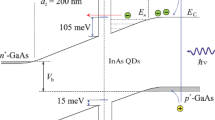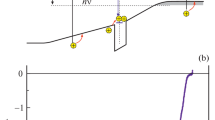Abstract
The electric-field behavior of resonance features of the photoelectric characteristics of InAs/GaAs heterostructures is investigated. The emission of carriers excited by light from InAs quantum dots into the GaAs matrix is discussed. It is shown that at the temperature of liquid nitrogen the photocurrent in a strong transverse electric field is only determined by the effect of electron tunneling through a barrier formed at the quantum-dot interfaces. Comparison of the experimental curves with the results obtained using a quasiclassical expression for the tunneling-current component and subsequent analysis of the potential structure made it possible to refine the parameters of the heterostructure under study. The contribution of the resonance component caused by possible electron tunneling through the barrier with the participation of the local defect states to the total tunneling current is analyzed. The influence of the level of excitation of the system on the photocurrent flowing through the InAs/GaAs heterojunction is theoretically studied.
Similar content being viewed by others
REFERENCES
N. N. Ledentsov, V. M. Ustinov, V. A. Shchukin, P. S. Kop’ev, Zh. I. Alferov, and D. Bimberg, Semiconductors 32, 343 (1998).
I. A. Dmitriev and R. A. Suris, Semiconductors 35, 212 (2001).
J. Lu, P. T. Webster, S. Liu, Y. H. Zhang, S. R. Johnson, and D. J. Smith, J. Cryst. Growth 425, 250 (2015).
E. S. Shatalina, S. A. Blokhin, A. M. Nadtochy, A. S. Payusov, A. V. Savelyev, M. V. Maximov, A. E. Zhukov, N. N. Ledentsov, A. R. Kovsh, S. S. Mikhrin, and V. M. Ustinov, Semiconductors 44, 1308 (2010).
P. W. Fry, I. E. Itskevich, S. R. Parnell, J. J. Finley, L. R. Wilson, K. L. Schumacher, D. J. Mowbray, M. S. Skolnick, M. Al-Khafaji, A. G. Cullis, M. Hopkinson, J. C. Clark, and G. Hill, Phys. Rev. B 62, 16784 (2000).
G. Torelly, R. Jakomin, L. D. Pinto, M. P. Pires, J. Ruiz, P. G. Caldas, R. Prioli, H. Xie, F. A. Ponce, and P. L. Souza, J. Cryst. Growth 434, 47 (2016).
A. Hospodková, J. Pangrác, M. Zíková, J. Oswald, J. Vyskočil, P. Komninou, J. Kioseoglou, N. Florini, and E. Hulicius, Appl. Surf. Sci. 301, 173 (2014).
B. N. Zvonkov, I. A. Karpovich, N. V. Baidus’, D. O. Filatov, and S. V. Morozov, Semiconductors 35, 93 (2001).
P. Waltereit, J. M. Fernandez, S. Kaya, and T. J. Thornton, Appl. Phys. Lett. 72, 2262 (1998).
V. A. Pogrebnyak, V. M. Yakovenko, and I. V. Yakovenko, Phys. Solid State 39, 1677 (1997).
Z. S. Gribnikov, K. Hess, and G. A. Kosinovsky, J. Appl. Phys. 77, 1337 (1995).
P. M. Mensz, S. Luryi, A. Y. Cho, D. L. Sivco, and F. Ren, Appl. Phys. Lett. 57, 2558 (1990).
M. L. Orlov and L. K. Orlov, Semiconductors 43, 652 (2009).
T. Sugaya, K. Y. Jang, C. Koo, K. Komori, A. Shinoda, and K. Yonei, J. Appl. Phys. 97, 034507 (2005).
L. K. Orlov, A. A. Mel’nikova, M. L. Orlov, N. A. Alyabina, N. L. Ivina, V. N. Neverov, and Zs. Horvath, Phys. E (Amsterdam, Neth.) 51, 87 (2013).
C. M. A. Kapteyn, F. Heinrichsdorff, O. Stier, R. Heitz, M. Grundmann, N. D. Zakharov, D. Bimberg, and P. Werner, Phys. Rev. B 60, 14265 (1999).
N. S. Volkova, A. P. Gorshkov, D. O. Filatov, and D. S. Abramkin, JETP Lett. 100, 156 (2014).
I. A. Karpovich, B. N. Zvonkov, S. B. Levichev, N. B. Baidus’, S. V. Tikhov, D. O. Filatov, A. P. Gorshkov, and S. Yu. Ermakov, Semiconductors 38, 431 (2004).
E. N. Korol’, Sov. Phys. Solid State 19, 1327 (1977).
R. A. Suris, Sov. Phys. Semicond. 20, 1258 (1986).
ACKNOWLEDGMENTS
We are grateful to A.P. Gorshkov and T.O. Mishenko for help in the measurements and calculations. The measurements were performed on the structures synthesized by B.N. Zvonkov at the Physical-Technical Research Institute of the Nizhny Novgorod State University.
This study was carried out in the framework of the Federal Target Program “Scientific and Scientific-Pedagogical Personnel for Innovative Russia” in 2009–2013, applications 2011-1.2.1-12-000-2013-095 and 2012-1.3.1-12-000-2003- 031 (no. 8543). Authors thank also RFBR (grant 18-42-520062) for the support.
Author information
Authors and Affiliations
Corresponding author
Additional information
Translated by E. Bondareva
Rights and permissions
About this article
Cite this article
Orlov, M.L., Volkova, N.S., Ivina, N.L. et al. Electric-Field Behavior of the Resonance Features of the Tunneling Photocurrent Component in InAs(QD)/GaAs Heterostructures. Semiconductors 52, 1129–1136 (2018). https://doi.org/10.1134/S1063782618090129
Received:
Published:
Issue Date:
DOI: https://doi.org/10.1134/S1063782618090129




